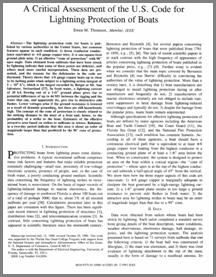A Critical Assessment of the U.S. Code for Lightning Protection of Boats

Ewen M. Thomson, Member, IEEE
Protecting boats from lightning poses some distinctive problems. A typical recreational sailboat comprises many risk factors and features that make reliable protection extremely challenging - small size, proximity of low-voltage electronic systems, presence of people, and, in the case of fresh water, a poorly conducting ground medium. Scientific data concerning the frequency of lightning strikes to recreational boats is nonexistent. On the basis of repair records of lightning-induced damage to marine electronics, the frequency of damage in southwest Florida is about 100 boats out of a total of perhaps 3000, that is, about 3% of all moored sailboats per year. There has been significant recent interest in lightning protection of structures, distribution lines, and telecommunication systems. In contrast, little concerning lightning protection of boats has appeared in scientific literature since the nineteenth century.
More than a century later:
1) Boat manufacturers are not obliged to install lightning protection during or after manufacture and frequently do not;
2) Manufacturers of marine electronics similarly are not obliged to include transient suppressors to limit damage from lightning-induced overvoltages and typically do not;
3) Despite the barrage from the popular press, many boats remain unprotected.
Click here to read the full paper (7 pages, 824 KB)